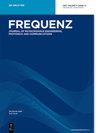Compact quadband two-port antenna with metamaterial cell-inspired decoupling parasitic element for mobile wireless applications
IF 1
4区 工程技术
Q4 ENGINEERING, ELECTRICAL & ELECTRONIC
引用次数: 1
Abstract
Abstract In this paper, a quadband MIMO diamond-shaped antenna with two highly isolated elements is proposed and discussed. A novel metamaterial cell-inspired decoupling parasitic structure is deployed between the two antenna elements to achieve high isolation greater than 20 dB in the frequency bands of interest. Moreover, the design adopts a defected ground structure and open-ended multiple diamond-shaped branches for multiband characteristics, enabling the proposed MIMO to cover several modern wireless applications. The performance metrics of the proposed MIMO antenna are validated by evaluating various diversity parameters such as envelope correlation coefficient (ECC), diversity gain (DG), total active reflection coefficient (TARC), and channel capacity loss (CCL). This antenna is fabricated on an FR4 substrate with a compact size of 12 × 30 × 1.524 mm (0.082λ0 × 0.204λ0 × 0.001λ0, λ0 is the wavelength at 2.04 GHz). With the edge-to-edge separation distance of 0.053λ0 between the antenna elements, its prototype is experimentally measured using a two-port Rohde & Schwarz ZVA50 Vector Network Analyzer. The port-to-port isolation is about −20.87 dB, −23 dB, −25.93 dB, and −25.22 dB for 2.3 GHz, 3.18 GHz, 4.08 GHz, and 5.42 GHz frequency bands, respectively. Also, the proposed MIMO antenna exhibits good diversity performances with the ECC < 0.005, DG > 9.99, and TARC<−10 dB making it an outstanding candidate covering 4G/LTE, 5G NR sub-6 GHz n40/n41/n77/n78, Wi-Fi, WiMAX, ISM, WBAN, Bluetooth, MBAN, WiBro, C-V2X, and UWB applications.紧凑型四频双端口天线,具有超材料蜂窝启发的去耦寄生元件,用于移动无线应用
摘要本文提出并讨论了一种具有两个高度隔离元件的四频带MIMO菱形天线。在两个天线元件之间部署了一种新颖的超材料单元启发去耦寄生结构,以在感兴趣的频带中实现大于20dB的高隔离。此外,该设计采用了缺陷接地结构和开放式多个菱形分支来实现多频带特性,使所提出的MIMO能够覆盖多种现代无线应用。通过评估各种分集参数,如包络相关系数(ECC)、分集增益(DG)、全有源反射系数(TARC)和信道容量损失(CCL),验证了所提出的MIMO天线的性能指标。该天线在FR4基板上制造,其紧凑尺寸为12×30×1.524 mm(0.082λ0×0.204λ0×0.001λ0,λ0为2.04 GHz的波长)。在天线元件之间的边缘到边缘分离距离为0.053λ0的情况下,使用双端口Rohde&Schwarz ZVA50矢量网络分析仪对其原型进行了实验测量。2.3 GHz、3.18 GHz、4.08 GHz和5.42 GHz频带的端口到端口隔离分别约为−20.87 dB、−23 dB、−25.93 dB和−25.22 dB。此外,所提出的MIMO天线表现出良好的分集性能,ECC<0.005,DG>9.99,TARC<−10dB,使其成为覆盖4G/LTE、5G NR sub-6 GHz n40/n41/n77/n78、Wi-Fi、WiMAX、ISM、WBAN、蓝牙、MBAN、WiBro、C-V2X和UWB应用的优秀候选者。
本文章由计算机程序翻译,如有差异,请以英文原文为准。
求助全文
约1分钟内获得全文
求助全文
来源期刊

Frequenz
工程技术-工程:电子与电气
CiteScore
2.40
自引率
18.20%
发文量
81
审稿时长
3 months
期刊介绍:
Frequenz is one of the leading scientific and technological journals covering all aspects of RF-, Microwave-, and THz-Engineering. It is a peer-reviewed, bi-monthly published journal.
Frequenz was first published in 1947 with a circulation of 7000 copies, focusing on telecommunications. Today, the major objective of Frequenz is to highlight current research activities and development efforts in RF-, Microwave-, and THz-Engineering throughout a wide frequency spectrum ranging from radio via microwave up to THz frequencies.
RF-, Microwave-, and THz-Engineering is a very active area of Research & Development as well as of Applications in a wide variety of fields. It has been the key to enabling technologies responsible for phenomenal growth of satellite broadcasting, wireless communications, satellite and terrestrial mobile communications and navigation, high-speed THz communication systems. It will open up new technologies in communications, radar, remote sensing and imaging, in identification and localization as well as in sensors, e.g. for wireless industrial process and environmental monitoring as well as for biomedical sensing.
 求助内容:
求助内容: 应助结果提醒方式:
应助结果提醒方式:


